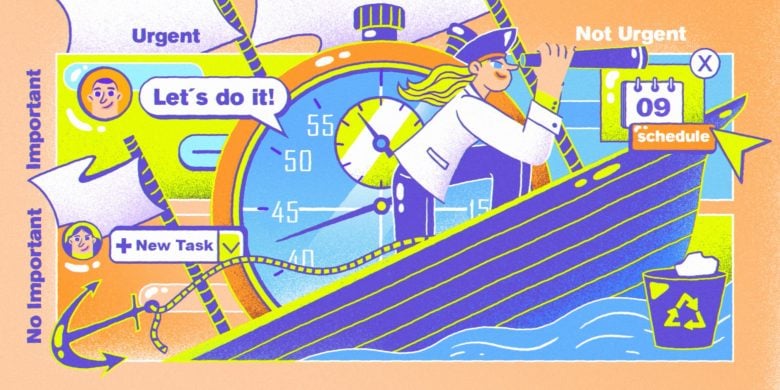Before we talk about remote work burnout, let’s talk about rock and roll. In Neil Young’s My My, Hey Hey (Out of the Blue), he utters the line, “It’s better to burn out than to fade away.” About 15 years later, the line appeared in Nirvana frontman Kurt Cobain’s suicide note.
While this is definitely the darkest intro to a post I’ve ever written, it’s an important anecdote that reminds us how crucial it is to learn how to prevent employee burnout.
Burnout has become a bit of a buzzword lately, but it really can cause harm to you and your employees. In fact, working 55+ hours a week lowers life expectancy and increases the chance of having a stroke by 35%. Burnout can also trigger insomnia, headaches, decreased immunity, and depression.
Studies have shown that remote workers actually work longer and harder than their in-office counterparts. This can then lead to remote loneliness—a “public health crisis,” according to the US Department of Health and Human Services.
By now, you’re probably well aware of the dangers of burnout, but why is it happening? Let’s delve in.
Boost your team’s efficiency with Hubstaff's productivity tools
Why is remote work burnout happening?
Work-from-home burnout is different from in-office burnout in that it’s often caused by a lack of social interaction, blurred work-life boundaries, and other risk factors that are unique to remote work.
As a fully remote company, Hubstaffers are usually the first to admit that remote communication challenges can also lead to burnout. Here is what we know.
75% of workers experience burnout at some point in their lives, but work-from-home burnout is a little different. When you live in the same space you work, it can be hard to set proper boundaries. This can then lead to an inability to separate work and personal life, which results in overwork.
Remote loneliness is a very real issue that leads to workplace stress and emotional exhaustion that plagues remote teams around the globe. Fortunately, you can help your employees combat it by prioritizing the Remote Employee Experience (REX).
But, how can you spot burnout before an employee goes up in flames? We have some ideas.
3 warning signs of remote employee burnout
The World Health Organization (WHO) officially acknowledged workplace burnout as a medical condition in its 2022 International Classification of Diseases (ICD-11).
WHO is currently working to establish guidelines that can help organizations prevent burnout. For now, it’s up to managers and Human Resources to notice when team members show signs of burnout and work to improve their situation.
This can be especially tricky for remote teams. Though there aren’t physical symptoms, here are five warning signs of burnout you can watch for and act on before you lose an employee.
Decreased productivity
One of the more obvious warning signs of employee burnout is decreased productivity. Decreased productivity is evidenced by a team member not completing their work on time or showing a decrease in the number of projects they complete.
Some managers may mistake decreased productivity for a remote employee who is slacking off. But when reduced productivity is combined with these other signs of burnout, it’s time to make a change.
Detachment
If an employee starts skipping out on virtual team-building events or seems less interested in meetings, they could be pulling away. Not to scare you, but detachment is often a sign that an employee is so burned out that they’re beginning to look for a new job. In fact, 95% of HR leaders feel that burnout is sabotaging workforce retention.
Absenteeism
If you notice a team member taking excessive PTO or sick days, you might consider this a sign of burnout. Combined with other factors on this list, it could signify that they’ve been too busy. This can be harder to track for remote teams, but an excessive number of sick days likely won’t go unnoticed.
Your first thought might be that your team member is looking for a new job during this time off. In reality, their unsustainable workload might have left them looking for extra time to decompress. Regardless, it’s not a good sign when an employee is absent more than usual. Learn how to manage absenteeism.
What causes these signs of employee burnout?
If your team members have high burnout risk, you should be especially vigilant in watching for signs of burnout. The Mayo Clinic considers these job conditions to be burnout risk factors:
- Heavy workloads and long work hours
- Work-life balance issues
- Working in a helping industry like health care or law enforcement
- No control over your work (schedule, workload, etc.)
Remote working conditions can cause employee burnout. It’s important to remember that company leadership often inadvertently creates these conditions. It’s important to remember that company leadership often inadvertently creates these conditions.
If you think your team is immune to burnout risk factors, you might want to think again. The number of employees who experience burnout is startling.
Over three-quarters of the workforce claim to experience burnout from their job. This number proves that widespread burnout is a challenge that all managers should take steps to minimize.

Be cautious not to create an environment where employees feel overworked and overwhelmed. Giving your team more work may backfire and lead to productivity issues and high turnover.
10 tips to prevent remote workplace burnout
Chronic job stress can result in exhaustion, frustration, and a lack of productivity at work — but burnout is much more than just feeling overwhelmed at work. It can also impact your team’s health.
According to the Mayo Clinic, workplace burnout can cause insomnia, heart disease, vulnerability to illness, and even Type 2 diabetes.
Applying simple solutions to this critical issue won’t cut it. That’s why you must take significant steps to prevent workplace burnout before your team faces these severe consequences.
Monitor excessive work hours
Long work hours are also a risk factor for burnout. When combined with a lack of breaks or flexibility, studies have shown that they’re detrimental to your team’s health. The World Health Organization found that excessive work hours led to 745,000 deaths in one year.
To combat this, establish a policy for overtime and consider limiting your team’s work hours. This will also help you keep overtime costs to a minimum.
Set clear expectations
Clear boundaries and expectations can help your team understand what you expect from them. Setting reasonable goals and guidelines for your team can eliminate stress by letting them know what success looks like in their position.
These expectations might include workday hours, communication standards, and project completion rate. When you set clear expectations, your team will feel more comfortable in their role and know how to succeed.
Give and receive feedback
Communication is crucial to minimizing burnout. Check-in with remote team members regularly, give them feedback on their performance and be willing to receive feedback in return.
Constructive feedback can help them perform better, and positive feedback can let them know when they’re on the right track. When your team knows they can come to you with issues, you open the door to conversations that can prevent burnout.
Manage workloads
Carefully managing your remote team’s workload can be one of the best ways to minimize their risk of burnout. Effective workload management can be the difference between a successful, productive team and a burnt-out workforce. Strategically assign tasks and let team members know they can approach managers about their workload whenever needed.
Make sure employees aren’t overloaded with meetings that are bogging them down and leading to burnout.

Offer flexible schedules
If your industry allows for it, create a flexible work policy. This can include working from home or flexible hours. If you can’t accommodate a flexible work schedule, encourage your team to work reasonable hours and take breaks.
A healthy work-life balance can improve your team’s productivity. When team members can step away from work to walk their dogs or spend time with loved ones, it may enhance engagement levels and decrease burnout. In fact, employees with an excellent work-life balance work 21% harder than those who don’t.
Employee appreciation
Employees who are overworked and underappreciated are more likely to experience burnout. Making team members aware of their hard work and contributions is a great way to keep them motivated and engaged.
Try to get creative with employee appreciation by endorsing them on LinkedIn or sending a personal message acknowledging their progress. If you need some ideas, check out our employee appreciation examples.
Offer support
A lack of support can lead to employee burnout. When you help team members manage their workload, you can reduce their risk of burnout and strengthen your team’s bond.
You can help your team by eliminating bottlenecks and managing workplace stress. Encourage all team members to support their colleagues and model this behavior by helping your team.
Cultivate your company culture
Improving your company’s employee experience is a great way to reduce stress and encourage employee engagement. One way to do this is to create a healthy company culture that prioritizes a work-life balance for your team.
If you manage a remote team, remote company culture is especially important. Organize regular check-ins with your team and come up with clever ways to strengthen team chemistry across borders.
Ensure employee well-being
Self-care and physical wellness are crucial steps to reducing burnout. As a business owner or manager, you can consider talking to your HR department about including mental health or counseling in your health care package.
Or, create incentives for your team members to get exercise. According to the Anxiety & Depression Association of America, physical health can help you better cope with stress.
Work on employee engagement
Employee engagement can benefit productivity and improve your employee experience. The Harvard Business Review found that organizations with a high level of engagement are 22% more productive than those that don’t.
An engaged workforce is more likely to be productive and content in their work. Use our employee engagement ideas for inspiration.
Final words
It’s crucial to address burnout before it impacts your team’s mental health and productivity. It’s better to take steps to prevent burnout before it occurs rather than reverse its effects once they’ve set in.
Even if one burnt-out employee starts to fall behind on work, it could spread to others. When the employee’s team steps in to help, they’ll have to increase their respective workloads too. After all, burnout stems from the work environment you create, not your team members.
Use our tips to deal with workplace burnout before it becomes a problem for your organization. You can prevent burnout by managing your team’s workload, organizing regular check-ins, and creating a healthy company culture.
Here’s where the shameless plug comes in. Manage workloads more effectively with a time management tool like Hubstaff. You can see how remote employees track time for different tasks, identify productive and unproductive apps, and see real-time employee productivity data to ensure workloads are balanced.

Using the right tools to check in could help your team improve retention rates and productivity moving forward.
Most popular
The Critical Role of Employee Monitoring and Workplace Security
Why do we need employee monitoring and workplace security? Companies had to adapt fast when the world shifted to remote work...
15 Ways to Use AI in the Workforce
Whether through AI-powered project management, strategic planning, or simply automating simple admin work, we’ve seen a dramatic...
The AI Productivity Panel: Lessons From Leaders on What’s Working (and What’s Not)
When I moderated this AI productivity panel, I expected a solid conversation. What I didn’t expect was the flood of real-world i...
Employee Performance Dashboards: Templates, Tools, and Best Practices
Keeping track of how your team’s really doing can be tricky. Spreadsheets pile up, one-on-ones only tell part of the story, and...




